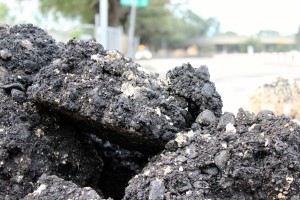Science
Houston’s Heat Risk Escalates Due to Abandoned Structures

A recent study conducted by researchers from Texas A&M University has uncovered a significant factor contributing to dangerously high surface temperatures in Houston, a city already ranked among the ten hottest in the United States. The research team, led by lecturer Dingding Ren, utilized thermal imaging technology mounted on drones to examine the heat profiles of various locations across Houston.
The study involved capturing over 1,400 drone images and integrating this data with satellite information from NASA‘s LandSat program to evaluate heat risks in residential, commercial, and industrial areas. The findings reveal a stark contrast between vegetated land and abandoned structures, with the latter significantly raising surface temperatures due to their heat-retaining characteristics.
Link Between Surface Temperature and Social Vulnerability
Ren highlighted that surfaces such as concrete, asphalt, and gravel absorb heat during the day and release it slowly at night, exacerbating the urban heat island effect. In contrast, areas with vegetation can be as much as 20 degrees Fahrenheit cooler than those dominated by abandoned buildings and paved lots.
The research also correlated higher surface temperatures with increased social vulnerability. Communities experiencing elevated heat levels face greater risks during natural disasters, raising concerns about public health and safety in these areas.
“The finding highlights the need for targeted cooling strategies,” Ren stated. He emphasized the importance of implementing passive cooling mechanisms, such as improved infrastructure and land reuse, to mitigate heat risks and enhance climate resilience in vulnerable communities.
Potential for Green Infrastructure Improvements
According to the study, Houston is home to approximately 45,000 acres of vacant land and 10,000 acres of abandoned buildings. Ren sees these areas as opportunities for enhancing green infrastructure, which could help reduce local microclimates and provide relief from extreme heat.
Passive cooling mechanisms are defined as design strategies that either eliminate heat or prevent it from entering specific areas or buildings. Ren remarked, “The vacant and abandoned land is a missed opportunity because there are many passive cooling systems that can help to reduce the local microclimate.”
This research underscores the urgent need for cities like Houston to address the challenges posed by urban heat and to develop sustainable solutions that promote community well-being and environmental resilience. By focusing on effective land use and infrastructure improvements, the city can work towards alleviating the heat burden on its residents, particularly those in the most vulnerable neighborhoods.
-

 Science2 months ago
Science2 months agoInventor Achieves Breakthrough with 2 Billion FPS Laser Video
-

 Health2 months ago
Health2 months agoCommunity Unites for 7th Annual Into the Light Walk for Mental Health
-

 Top Stories2 months ago
Top Stories2 months agoCharlie Sheen’s New Romance: ‘Glowing’ with Younger Partner
-

 Entertainment2 months ago
Entertainment2 months agoDua Lipa Aces GCSE Spanish, Sparks Super Bowl Buzz with Fans
-

 Health2 months ago
Health2 months agoCurium Group, PeptiDream, and PDRadiopharma Launch Key Cancer Trial
-

 Top Stories2 months ago
Top Stories2 months agoFormer Mozilla CMO Launches AI-Driven Cannabis Cocktail Brand Fast
-

 Entertainment2 months ago
Entertainment2 months agoMother Fights to Reunite with Children After Kidnapping in New Drama
-

 World2 months ago
World2 months agoIsrael Reopens Rafah Crossing After Hostage Remains Returned
-

 World2 months ago
World2 months agoR&B Icon D’Angelo Dies at 51, Leaving Lasting Legacy
-

 Business2 months ago
Business2 months agoTyler Technologies Set to Reveal Q3 Earnings on October 22
-

 Health2 months ago
Health2 months agoYouTube Launches New Mental Health Tools for Teen Users
-

 Health2 months ago
Health2 months agoNorth Carolina’s Biotech Boom: Billions in New Investments









